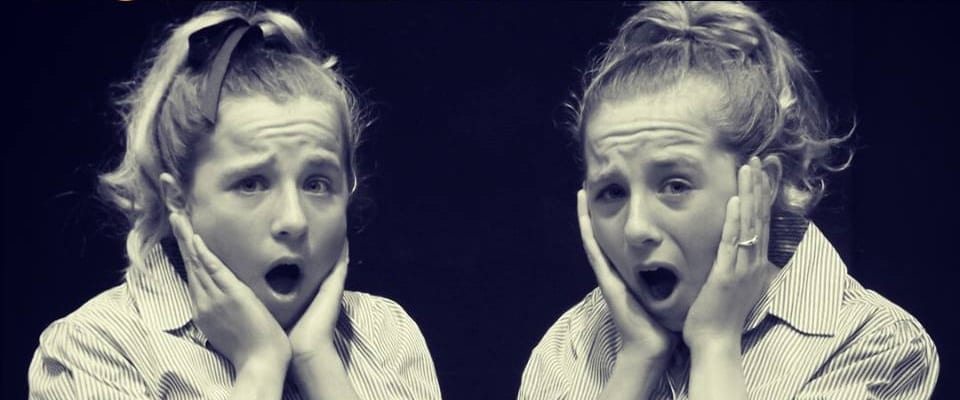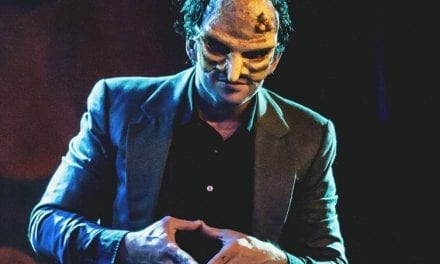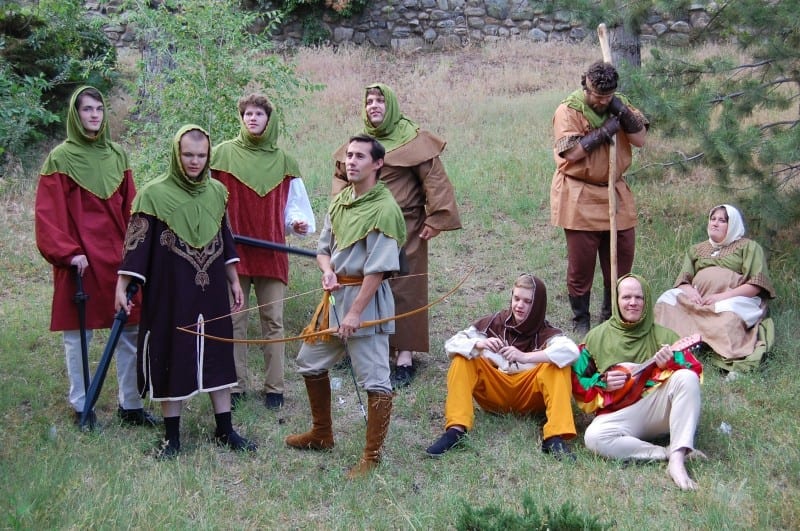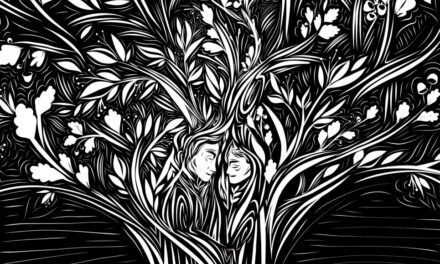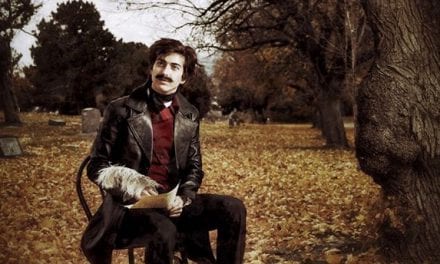SOUTH SALT LAKE — Parent Trap under the direction of Joanne Parker at Utah Children’s Theatre meets expectations, even if it doesn’t exceed them. The Utah Children’s Theatre is locally known for taking stories popularized by Disney and re-inventing them on stage or taking those stories back to their literary roots. In this production, however, Parker deliberately pays homage to the 1961 Disney film starring Hailey Mills and Maureen O’Hara in which two girls go to summer camp only to find out that they are identical twins separated shortly after birth and then scheme to get their parents back together after “switching” places.

Show closes May 26, 2018.
The play opens with what appears to be film credits projected on a screen that creates a frame over and on each side of the stage. The credits are designed to look as if they came from a movie in the 1960s and list all artists involved in this production. They are accompanied by similarly-themed 1960s movie music. After this initial projection, all other projections in the show are designed to suggest a setting or display graphics that might have been popular in that decade. The set design by James B. Parker similarly hearkens to that time and the original film, as everything on set seems to be in a bright and happy Technicolor.
The play also follows a similar storyline from the 1961 movie, though, like the 1998 movie remake staring Lindsay Lohan, the names of the girls are changed, as are their parent’s professions. In the play, the girls are named Lizzie and Lottie, played by real-life sisters Mary Cemyar and Naomi Cemyar, respectfully. Lizzie lives in California with her baker mom, Annie (played by Missy Stebbing) and Lottie lives in New York City (not Boston) with her orchestra-conducting father, Jim (played by Sean Sweeney). The two girls meet at summer camp in Minnesota—not Maine, as in the movie. Barring these differences, however, the story is basically the same. There are funny tricks played at camp and on Jim’s fiancé, Georgiana. There is also heartfelt rediscovery of family. That said, re-creating the “feel” of a movie on stage is nearly impossible.
 It seems as if something is always lost in film to stage adaption (and vice versa, of course). For instance, in the canoe scene, though skillfully directed, Lottie’s fall into the lake isn’t nearly as effective for lack of real water to fall into. Furthermore, movies can get away with much more intimate talking that plays can (in theatre for youth, especially) because of the intimacy created by the frame of the movie screen. Simply said, although there are plenty of “action” scenes, the play also has its share of “conversation” scenes, and the littler kids in the audience had difficulty keeping their attention on stage. I witnessed this first-hand with my four-year-old (who attends the theatre rather frequently) sitting next to me, but also saw other little people fidgeting mightily, in and out of their seats. So, if you do go, I would suggest bringing children at least seven years old and above.
It seems as if something is always lost in film to stage adaption (and vice versa, of course). For instance, in the canoe scene, though skillfully directed, Lottie’s fall into the lake isn’t nearly as effective for lack of real water to fall into. Furthermore, movies can get away with much more intimate talking that plays can (in theatre for youth, especially) because of the intimacy created by the frame of the movie screen. Simply said, although there are plenty of “action” scenes, the play also has its share of “conversation” scenes, and the littler kids in the audience had difficulty keeping their attention on stage. I witnessed this first-hand with my four-year-old (who attends the theatre rather frequently) sitting next to me, but also saw other little people fidgeting mightily, in and out of their seats. So, if you do go, I would suggest bringing children at least seven years old and above.
Another challenge with this movie is its large cast of youth. Of course it is positively delightful to see so many young people on stage (boys and girls, though the boys have only two crowd-scene cameos in this production). They are full of light, vitality, and genuine joy, and this energy feeds into the audience (the dance scene is especially delightful). That said, young actors are still honing this difficult craft, and, in the camp scenes much of the vocal projection sounded like yelling. The children’s acting was also often telegraphic, though this probably works best for the young people in the audience who might need help to follow the plot. Mary and Naomi Cemyar, however, delivered delightful performances. Quite simply, it is fun to watch them have fun on stage.
 Five adults also make up the cast. Stebbing and Sweeney play their roles well, as do Larissa Anderson as camp counselor Miss Connie, and Brighton Nichole Sloan doubling as camp counselor Chatworth and Aunt Louisa, and Steve Harmon who plays Dilworth. It is Meighan Smith who stands out, however, as the camp cook Magee and Jim’s fiancé Georgiana. Both are character roles, and Smith excels at physical comedy, commanding the stage whenever she is on it. Smith also serves as hair and make-up designer for the show, which is fitting because both or her characters are heavily enhanced by their hairdos. Smith’s work with hair and make-up complemented the costume design by Julie Anderson. Everything seemed appropriate to the time period and as joyfully colorful as James Parker’s set design.
Five adults also make up the cast. Stebbing and Sweeney play their roles well, as do Larissa Anderson as camp counselor Miss Connie, and Brighton Nichole Sloan doubling as camp counselor Chatworth and Aunt Louisa, and Steve Harmon who plays Dilworth. It is Meighan Smith who stands out, however, as the camp cook Magee and Jim’s fiancé Georgiana. Both are character roles, and Smith excels at physical comedy, commanding the stage whenever she is on it. Smith also serves as hair and make-up designer for the show, which is fitting because both or her characters are heavily enhanced by their hairdos. Smith’s work with hair and make-up complemented the costume design by Julie Anderson. Everything seemed appropriate to the time period and as joyfully colorful as James Parker’s set design.
Joanne Parker’s direction is always skilled, and The Parent Trap is no exception. She skillfully builds up the antagonistic relationship of the sisters and then brings it crashing down. Movement on stage is seamless or carefully organized chaos. The scenes move quickly, though sometimes a little too quickly. It almost seemed as if too much was packed into each act—the play is a full two hours including intermission.
One final note. This play (like the film) is meant to be little more than heartwarming entertainment. That said, I couldn’t help but wonder if the ending opened some wounds in the audience. In the 1960s the divorce rate was half of what it is now. Moreover, the happy ending in Parent Trap is Disney fantasy, and I couldn’t help but feel a little self-conscious for any kids in the audience that might come from broken homes and, like Lizzie and Lottie, secretly wish for a mother or father. If such a situation is a sensitive point for your family, it may be best to sit this one out.
Donate to Utah Theatre Bloggers Association today and help support theatre criticism in Utah. Our staff work hard to be an independent voice in our arts community. Currently, our goal is to pay our reviewers and editors. UTBA is a non-profit organization, and your donation is fully tax deductible.

